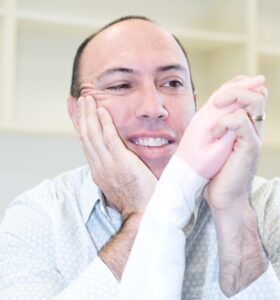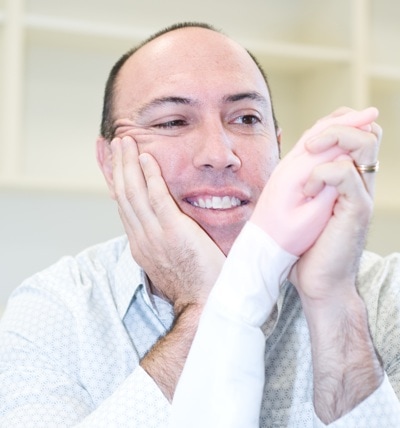I was unsure about that title, but I figured it’s holiday season and I am going to talk about work I did with two Italians, and I know there are some Pink Floyd fans out there. Somewhere. If you have never heard of Pink or Floyd, then go with the subtitle – Space – temperature interactions in CRPS. Earlier this year, Alberto Gallace, Charlie Spence and I wrote a paper proposing this idea of a ‘cortical body matrix’ – a network of networks if you like, which serve the regulation and protection of the body and the space around it, both physiologically and psychologically. Now it is not particularly original – it draws heavily on Ron Melzack’s neuromatrix theory, and work done by the great Herta Flor, and of course, the neurotag concept discussed in Explain Pain. The advance, if that is not too generous, is that it integrates the process of regulation and protection at a tissue level with that at a psychological, or perceptual level. It is a useful theory (one that our group and others are now trying to disprove, such is the process of science) for making sense of some of the remarkable things we observe in people with chronic pain, and the things we evoke in experiments with healthy subjects. Check out the review paper to learn more.
Our latest publication, this time with Alberto and Giando, in BRAIN (go to our articles page to download the full article), strongly endorses the cortical body matrix idea by showing that people with CRPS, with a cold painful hand, actually seem to have a cold side of space.
We did five experiments, but they are all very simple. We asked people with CRPS of one arm to move their arms either side of the body midline and leave them there. We then recorded skin temperature using a very sensitive (and expensive!) thermal imaging camera. When participants crossed their hands in front of them and waited for 10 minutes, their cold painful hand warmed up and their healthy warm hand cooled down. When they put both hands on the affected side of the body midline, they both went cool. When they put them both on the healthy side, they both warmed up. The magnitude of the temperature shift related to how far beyond the body midline their hand was held. In one experiment we tested whether the position of the hand in space affects pain or the sense of ownership over the hand. It does, but only by a tiny amount and not enough to be a potential treatment. Still, that there was any shift at all raises the possibility that, as they say, ‘we might be onto something here’. Time will tell of course.
How do we make sense of this finding? It is difficult – very clever people in several countries are on the case – Prof Andre Moureax (you really should check him out – excellent run of papers and altogether excellent fellow) for one has observed that skin temperature is not constant, so what we are picking up is almost certainly not a stable baseline shift but a shift in average about which temperature is fluctuating. We would do well to constantly map the temperature rather than take snapshots. Regardless, these experiments show quite clearly that where the limb is in space interacts with thermoregulation – as though the spatial signature of the affected hand has taken over the thermoregulatory dysfunction. There are plausible mechanisms for this – brain areas that are thought to encode space have clear connections to the insula and brainstem nuclei associated with thermoregulatory function. These questions remain to be answered. For now, we can be pretty confident that blood flow in the hands in people with CRPS is affected by where the hand is in space. The next question for us is whether or not this effect depends on the true location of the hands or the perceived location of the hands. Stay tuned……
About Lorimer Moseley
 Lorimer is NHMRC Senior Research Fellow with twenty years clinical experience working with people in pain. After spending some time as a Nuffield Medical Research Fellow at Oxford University he returned to Australia in 2009 to take up an NHMRC Senior Research Fellowship at Neuroscience Research Australia (NeuRA). In 2011, he was appointed Professor of Clinical Neurosciences & the Inaugural Chair in Physiotherapy at the University of South Australia, Adelaide. He runs the Body in Mind research groups. He is the only Clinical Scientist to have knocked over a water tank tower in Outback Australia.
Lorimer is NHMRC Senior Research Fellow with twenty years clinical experience working with people in pain. After spending some time as a Nuffield Medical Research Fellow at Oxford University he returned to Australia in 2009 to take up an NHMRC Senior Research Fellowship at Neuroscience Research Australia (NeuRA). In 2011, he was appointed Professor of Clinical Neurosciences & the Inaugural Chair in Physiotherapy at the University of South Australia, Adelaide. He runs the Body in Mind research groups. He is the only Clinical Scientist to have knocked over a water tank tower in Outback Australia.
Link to Lorimer’s published research here. Downloadable PDFs here.
References
Moseley, G., Gallace, A., & Spence, C. (2012). Bodily illusions in health and disease: Physiological and clinical perspectives and the concept of a cortical ‘body matrix’ Neurosci Biobehav Rev, 36 (1), 34-46 DOI: 10.1016/j.neubiorev.2011.03.013
Moseley GL, Gallace A, & Iannetti GD (2012). Spatially defined modulation of skin temperature and hand ownership of both hands in patients with unilateral complex regional pain syndrome. Brain, 135 (Pt 12), 3676-86 PMID: 23250885



